Description
In recent years, significant experience of the effects of high wind and flooding on nuclear installations has been gained worldwide. These phenomena may simultaneously affect all the structures, systems and components important to safety at a nuclear installation site. By detailing the methodologies and providing case studies for the evaluation of meteorological and hydrological hazards, this publication supports IAEA Safety Standards Series No. SSG-18, Meteorological and Hydrological Hazards in Site Evaluation for Nuclear Installations. In the first part of the publication, wind hazards relating to tropical cyclones, tornadoes, extratropical storms, thunderstorms and wind-borne debris are discussed. The second part covers external flooding hazards (excluding tsunamis) relating to wind induced coastal flooding, wind generated waves on rivers, extreme precipitation and runoff events and the sudden release of impounded water.
More Information on reusing IAEA copyright material.
Keywords
IAEA Safety Reports, Assessment, High Wind, External Flooding, Hazards, Site Evaluation, Nuclear Installations, Nuclear Power Plants, Safety Measures, Nuclear Facilities, Natural Disasters, Practice Methods, Structures, Systems and Components, SSCs, Methodologies, Case Studies, Meteorological and Hydrological Hazards, Tropical Cyclones, Tornadoes, Extratropical Storms, Thunderstorms, Wind-Borne Debris, Wind Induced Coastal Flooding, Wind Generated Waves on Rivers, Extreme Precipitation, Runoff Events, Sudden Release of Impounded Water, Hazard Modelling, Meteorological Phenomena, Data Resources, Modelling Uncertainty, Statistics, Databases, Statistical Methods, Tail Limited Distributions, Deterministic and Probabilistic Methods of Analysis, Missile Impact Effects, Atmospheric Pressure Change, APC, Loads and Missile Surveys, Risk Assessment, Probabilistic Flood Hazard Assessment, PFHA, Review



